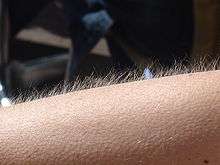Cold chill
A cold chill (also known as chills, the chills or simply thrills) is described by David Huron as, "a pleasant tingling feeling, associated with the flexing of hair follicles resulting in goose bumps (technically called piloerection), accompanied by a cold sensation, and sometimes producing a shudder or shiver." Dimpled skin is often visible due to cold chills especially on the back of the neck or upper spine. Unlike shivering, however, it is not caused by temperature, menopause, or anxiety but rather is an emotionally triggered response[1] when one is deeply affected by things such as music,[2][3] speech, or recollection. It is similar to autonomous sensory meridian response; both sensations consist of a pleasant tingling feeling that affects the skin on the back of the neck and spine.
See also
- Chills
- Autonomous sensory meridian response
- Frisson
References
- Maruskin, Laura A.; Todd M. Thrash; Andrew J. Elliot (7 May 2012). "The Chills as a Psychological Construct: Content Universe, Factor Structure, Affective Composition, Elicitors, Trait Antecedents, and Consequences". Journal of Personality and Social Psychology. 103 (1): 135–157. doi:10.1037/a0028117. PMID 22564010.
- David Huron. Biological Templates for Musical Experience: From Fear to Pleasure. Abstract
- Panksepp, J. (1995). "The emotional sources of chills induced by music" (PDF). Music Perception. 13 (2): 171–207. doi:10.2307/40285693. JSTOR 40285693.
